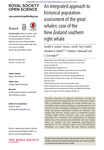Please use this identifier to cite or link to this item:
http://lib.hpu.edu.vn/handle/123456789/23618Full metadata record
| DC Field | Value | Language |
|---|---|---|
| dc.contributor.author | Jackson, Jennifer A. | en_US |
| dc.contributor.author | Carroll, Emma L. | en_US |
| dc.contributor.author | Smith, Tim D. | en_US |
| dc.date.accessioned | 2016-10-11T05:37:33Z | |
| dc.date.available | 2016-10-11T05:37:33Z | |
| dc.date.issued | 2016 | en_US |
| dc.identifier.other | HPU4160722 | en_US |
| dc.identifier.uri | https://lib.hpu.edu.vn/handle/123456789/23618 | en_US |
| dc.description.abstract | Accurate estimation of historical abundance provides an essential baseline for judging the recovery of the great whales. This is particularly challenging for whales hunted prior to twentieth century modern whaling, as population-level catch records are often incomplete. Assessments of whale recovery using pre-modern exploitation indices are therefore rare, despite the intensive, global nature of nineteenth century whaling. Right whales (Eubalaena spp.) were particularly exploited: slow swimmers with strong fidelity to sheltered calving bays, the species made predictable and easy targets. | en_US |
| dc.format.extent | 16 p. | en_US |
| dc.format.mimetype | application/pdf | en_US |
| dc.language.iso | en | en_US |
| dc.subject | Biology | en_US |
| dc.subject | Ecology | en_US |
| dc.subject | Whaling | en_US |
| dc.subject | Historical abundance | en_US |
| dc.subject | Southern right whale | en_US |
| dc.subject | Bottleneck | en_US |
| dc.title | An integrated approach to historical population assessment of the great whales | en_US |
| dc.type | Article | en_US |
| dc.size | 719KB | en_US |
| dc.department | Education | en_US |
| Appears in Collections: | Education | |
Files in This Item:
| File | Description | Size | Format | |
|---|---|---|---|---|
| 0605_Anintegratedapproach.pdf Restricted Access | 719.65 kB | Adobe PDF |  View/Open Request a copy |
Items in DSpace are protected by copyright, with all rights reserved, unless otherwise indicated.
